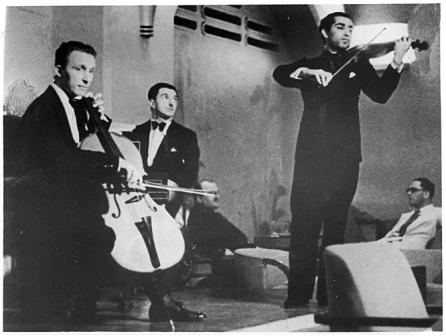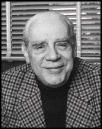All India Radio’s caller tune has been heard by hundreds of millions of people since it was composed in 1936. Somewhat improbably, the tune, based on raga Shivaranjini, was composed by the Czech man in the middle of the trio pictured above: Walter Kaufmann. He was the director of music at AIR and was one of the many Jewish refugees who found a haven in India from the Nazis. The violinist on the recording is thought to be Mehli Mehta, who is also in the image above.
Kaufmann had arrived in India in February 1934 and ended up staying for 14 years. Within a few months of landing in Bombay, Kaufmann founded the Bombay Chamber Music Society, which performed every Thursday at the Willingdon Gymkhana. At the performance pictured here, Kaufmann is at the piano, Edigio Verga is on cello and Mehta – the father of Zubin Mehta – is playing the violin. By May 1937, the Society had given 136 performances of works by old masters and modern composers. “Membership of the Society is open to all music lovers,” The Times of India reported. Full membership cost Rs 15 a month, but students, working women and missionaries could attend all concerts for only Rs 5 a month.
Kaufmann, whom I was prompted to remember after the excellent Rajesh Devraj wondered about him, was no ordinary musician. He was born in 1907 in Karlsbad in the former Czechoslovakia and in 1930 graduated from the Staatlich Hochschule für Musik in Berlin. He moved on to do a PhD in musicology at German University in Prague, though he refused to pick up his degree when he found out that one of his teachers, Gustav Becking, was the leader of the Nazi youth group. From 1927 to 1933, he conducted summer seasons of opera in Berlin, Karlsbad, and Eger.
The most detailed account of Kaufmann’s life in India is Agata Schindler’s essay, “Walter Kaufmann: A Forgotten Genius”, in the volume Jewish Exile in India: 1933-1945. The musician’s reason for coming to India was simple: “I could easily get a visa,” Schindler quotes him as saying in one of his letters.
In the same letter, the musician is disarmingly honest in describing his initial reactions to Indian music: the first records he heard were “alien and incomprehensible.” But Kaufmann wasn’t willing to give up. “As I knew that this music was created by people with heart and intellect, one could assume that many, in fact millions would be appreciating or in fact loving this music…I concluded that the fault was all mine and the right way would be to undertake a study tour to the place of its origin,” he wrote. His study would be so intense, it would result in books such as The Ragas of North India, The Ragas of South India : A Catalogue of Scalar Material and Musical Notations of the Orient: Notational Systems of Continental, East, South and Central Asia.
Kaufmann’s stint at AIR from 1937 to 1946 gave him the opportunity to learn from some of India’s greatest classical musicians. It also allowed him to observe some of their quirks. “Most of the older artists refused to accept their remunerations in the form of cheques. They insisted upon receiving bare coin,” he wrote. “It was interesting to note that some of these great and wonderful musicians would bring along with them a young boy, a son or a nephew, who was able to count the rupee coins reliably. The old artist and his young helper would settle on the floor outside the studio and carefully count the money received which had come in a little cloth bag.”
The sounds he absorbed were converted into a series of operas, ballets, chamber music works and film scores (as well as the AIR tune, of course). His compositions from the period, several of which were performed by the Bombay Chamber Music Society, included Ten String Quartets, Three Piano Trios, Indian Piano Concerto, Six Indian Miniatures and Navaratnam, according to Schindler’s article.
In addition to his job at AIR, Kaufmann worked for Bhavnani Films and for Information Films of India. He also lectured at Sophia College. Among his pieces with an Indian flavour was Anasuya, which made its debut in 1939. It was described as “India’s first radio opera”. The plot drew from the ancient European legend of King Cophetua, an African ruler who falls in love with a young beggar, but the story was transposed to a mythical Maratha state. In Kaufmann’s version, the African ruler became Maharaja Asok (played by Leo D’Souza) and the young beggar Penelophon became the eponymous Anasuya (played by Eva Manes).
Anasuya, like many of Kaufmann other works, was well received. The music “blends marvellously well Western technique with Eastern mood: in such a strain one looks forward to the day when he will permanently enrich the musical resources of the world”, cheered the Times.
The musician was an evangelist for new music. In 1938, for instance, he mounted an enthusiastic defence of experimental music at a Rotary Club meeting at Green’s Hotel. He bemoaned the general tendency to criticise modern music without giving it a proper hearing. “One can often hear people say, ‘Oh I love Bach but I don’t like the moderns.’ Is it not funny that a person born in our time should only understand music which was composed 300 or 200 years ago and should not care for the music of his own time?” he asked.
After Kaufmann left India, he spent some years in England and Canada, before moving to the US in 1957. He joined the School of Music faculty at Indiana University in Bloomington, where he continued to write extensively about Indian music. His papers can be viewed at the University Library. Kaufmann died in 1984.
Canada’s ARC Ensemble has recently been performing some of Kaufmann’s symphonic works. One of them can be found on this link and another is below.
In this video, Simon Wynberg of the ARC Ensemble talks about Kaufmann’s life and work.





7 comments
Very interesting. I note from some old czech documents I have, relating to Bombay ( 1910 to 1950) , a copy of an invitation card of Wednesday 7th March, 1945 at 6.30 PM , at the University Hall – ” Thirteenth Concert of the Bombay String Quartet – In commemoration of the birthday of the late President-Liberator of Czechoslovak Republik – Thomas G Masaryk . Mehli Mehta (1st Violin); Adrian deMello (2nd Violin), Rusi Mody (Viola), George Lester (violincello) with SHANTI SELDON (Pianoforte). A programme of Czechoslovak Chamber Music – (1) String Quartet in E minor (“From My Life”) – Smetana (2) Slavonic String Quartet (First Public Performance) by KAUFMANN ( Dedicated to the Bombay String Quartet) (3) Quintet for Piano & Strings in A major, Op. 81 – Dvorak – Bookings at S. Rose & Co. – Prices – Rs 4 & Rs 2 (Reserved) & Rs 1.4 (Unreserved) – Circulated to the Members of – The Bombay Symphony Orchestra Society; The Bombay Chamber Music Society; The Bombay Gramophone Society – Under the Patronage & in the presence of His Excellency, the Governor of Bombay”
I don’t know much about any of all this, though it is fascinating. I’m only here because I noted with delight that the first name in caps in the comment above, Shanti Seldon, was my piano teacher in the early 1970s. Everyone seemed to know that her name was really Cynthia Saldanha. Short, formidable and exacting, she nevertheless instilled a love for the instrument in me that endures, teaching me in her first floor flat in “Ivorine” opposite the Oval. I heard recently that she had died, though I didn’t see an obit if there was one. Anyone with some news about her?
Hi Dilip, I was a student of Shanti Seldon for 11 years and then I came abroad to pursue my Bachelors and Masters degree in piano. I spoke to her brother last year and he confirmed that she had indeed passed away. It was a peaceful death as she died in her sleep. I’m only here today because of her. She was something else.
Zubin Mehta explains his special love for Kashmir in an interview with Barkha Dutt today. ( See Final 2 mts here – from 29:35 onwards – http://www.ndtv.com/video/player/news/will-return-to-kashmir-if-it-wants-me-zubin-mehta-to-ndtv/289771 ) – Hearing his father play along Walter Kaufmann on All India Radio’s signature tune, on a late evening at Amarnath caves, Kashmir in the 1970s. Zubin Mehta reminds you about the great ” Czech-Jewish” music composer , whose wife was ” Kafka’s niece” , and they lived in India for many years. The German ambassador who’d sponsored the concert in Kashmir, sitting next to Zubin Mehta, nodded in agreement. Music heals through unity. Sad that sometimes musicians have to use words to explain it.
Another fantastic post. Thank you, Naresh. I have just read it. I was very little when my mother told me that the AIR signature tune had been composed by a white man. I don’t remember her exact words. May be she said an Englishman.
Thank you for sharing, Naresh. This is incredible, as was my Uncle Walter … Kaufmann. Also appreciated reading the above posts from others. He was a fascinating and wonderful man, to say the least, and while my memories are of a personal nature, and mostly from the 70’s, I recall the honor of attending the premiere of one of his beautiful Operas at Indiana University, (The Scarlet Letter).
With gratitude,
Simone Lazer
We are featuring Walter Kaufmann as a character in our play The Music In My Blood.
The play opens in NYC in June 2018.
please see the information here : https://www.facebook.com/themusicinmybloodNYC/